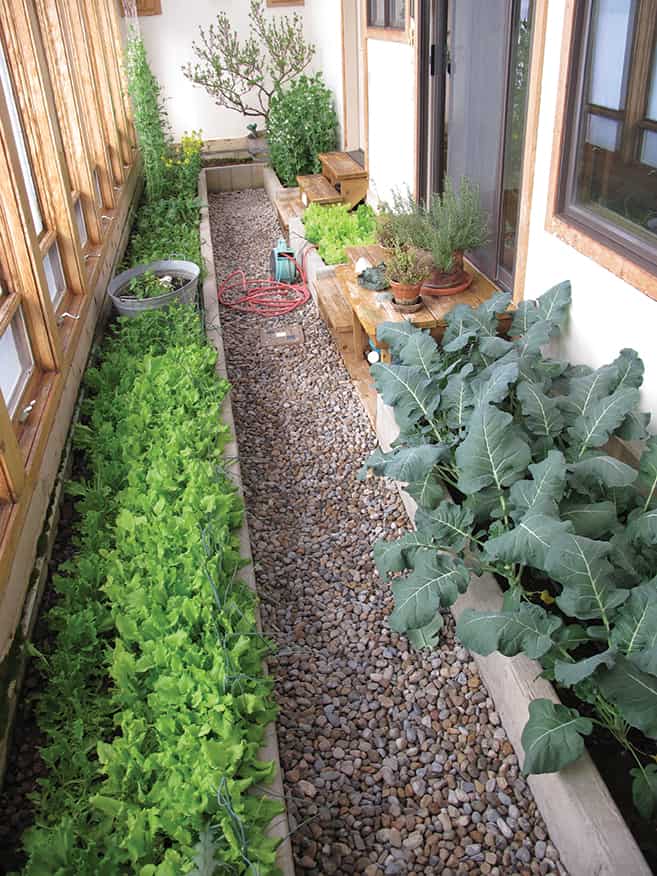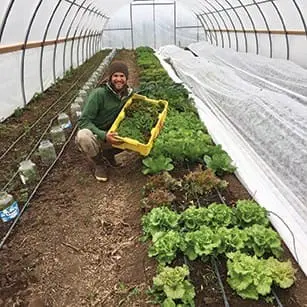By Molly Absolon // Photography provided
—
Gardening in the winter sounds like an oxymoron for our cold, snowy climate, as most of us—even those who have summer gardens—tend to harvest our produce from the grocery store once the snow begins to fly. But COVID-19 shook us up. Rumors of shortages and problems with distribution triggered a rush on toilet paper, hand sanitizer, food, and other essentials, including vegetable seeds. According to a May 13, 2020 article in Good Housekeeping, Burpee Seeds sold more seeds in March of 2020 than in any time in its 144-year history, and Google Trends, which tracks popular internet searches, reported that interest in gardening reached an all-time high during the same time period.
Recession, pandemic, war—hard times get people contemplating their food source. Not only do they want to think and act locally, but more importantly, they want to be sure to have enough food to feed their families. During World War I, Americans were encouraged to grow “victory gardens” to help avoid a national food crisis. Such gardens popped up in people’s backyards, parks, vacant lots, and on school grounds, resulting in more than 5,000,000 new gardens in 1918 alone. It’s hard to put a number on how many new vegetable gardens have sprung up in the Tetons in response to the pandemic, but anecdotally local farmers say they have had more people than ever calling for both their produce and their knowledge. People want to know how to grow their own food, and that includes finding ways to do it in all seasons.
Judy Allen has been growing food in the Tetons for 37 years. These days, she cultivates vegetables, root crops, and leafy greens year-round on her farm near the mouth of Darby Canyon in Driggs. Always a gardener, when she first came to the region from the Midwest, she wanted to start a horticulture program at Red Top Meadows (a residential wilderness treatment center in Wilson). Her boss at the time dismissed the idea, saying, “You know what people grow around here? Radishes.”
That was 1983. Since then, many of the region’s gardeners have proved him wrong and are growing all kinds of crops, not only in the summer but throughout the year. Allen says she never buys produce at the grocery store anymore, as the key to her success in the winter is her greenhouse. In fact, this structure—an integral part of her lifestyle—dictated the location, orientation, and design of the home that she and her husband built more than 20 years ago. The temperature can be 20°F outside, but if it’s sunny, Allen’s greenhouse will reach 80°F, and fans blow the excess heat into the house to keep it warm.
Allen’s greenhouse is a masterpiece of ingenuity. It faces fifteen degrees southeast to maximize solar gain. Concrete walls surround her planters and extend four or five feet into the ground. The concrete, plus the dirt and rocks that make up the greenhouse floor, provide thermal mass that absorbs and holds heat. Even snow helps generate heat in the space by radiating light off of its surface and into the 300-square-foot space.
“I didn’t intend to be a winter gardener, but when I looked at the temperatures in the greenhouse, I thought, let’s give this a whirl,” she says. “It’s fun to be planting when it’s snowing outside.”

The experiment was a success, causing Allen to branch out and try vegetables like greens, snow peas, kale, snap peas, over-winter broccoli (she claims it’s the best broccoli she’s ever tasted), and various other crops. The commonality among all the plants she grows is that they are hardy and can withstand cold temperatures.
“The lowest temperature I’ve recorded in my greenhouse is about 25 degrees,” she says. “Frost-tolerant crops can handle that. The key thing is you don’t want to try to grow tomatoes. It’s against my religion to heat the greenhouse to grow tomatoes.”
Tomatoes, and other summer crops, require heat to mature, but for winter-hardy plants, it isn’t heat that’s the determining factor in their success; it’s the amount of light in the day. Erica Eschholz, who runs Full Circle Farm near Victor with her husband, Ken Michael, says most plants need at least ten hours of light to grow. Once the length of sunlight in a day drops, which happens in early November at our latitude, plant growth slows. But “slow growth” does not mean “no growth.” Eschholz and Michael say that if you get winter-hardy crops—broccoli, lettuce, kale, bok choy—into the ground in a hoop house by October, they will grow slowly through the winter, accelerating as the days get longer, and they’ll be ready for harvest in the spring. Fast-growing plants—arugula, spinach, cilantro—that reach maturity by October can often be cut throughout the winter, giving growers a welcome taste of leafy greens in the middle of our darkest days.

To truly have a harvestable crop in the winter, most gardeners rely on some type of greenhouse, but it doesn’t have to be as extravagant as Allen’s. Plenty of farmers in the area have success growing winter crops in much less elaborate structures.
Josh Arthur, of Foraging Farmers in Victor, is an enthusiastic advocate of no-till farming, which requires an intricate cycle of rotating crops, compost (from his flock of chickens), and complementary planting. You can usually find a mushroom or two flourishing underneath the squash plant in his garden, and cilantro or some other quick-growing herb grows in every empty space between other crops. He says that there were only two weeks last winter when he and his partner, Courtney, did not eat out of their garden.
“We have a single-layer poly hoop house,” Arthur says. “If I can get plants to maturity within the 10-hour daylight window, I can keep harvesting into the winter. Then, once the days get longer in February, everything takes off again.”
According to Arthur, over-winter crops create sugars that act as a kind of anti-freeze, so everything tastes sweeter. Full Circle’s Michael says it’s not uncommon in January to find plants like carrots and potatoes with their leaves frozen solid. But that’s no reason to panic because under the ground, they are doing just fine.
“The plants are dormant,” he says. “Hardy crops can make it through temperatures well below zero. Once the days start getting longer, the plants will come back, and you’ll be eating carrots in the spring.”
The idea of eating fresh, homegrown greens in the middle of February is hard for many of us to imagine, but farmers in the Tetons have been doing it for years. It takes a little planning, and maybe a hoop house or greenhouse, to extend your growing season. Most importantly, your personal victory garden keeps you out of the grocery store, insulates you from any shortages or distribution problems, and makes you feel like you are contributing to the vitality of your community during hard and stressful times.
The Little Greenhouse that Could
—
Duane Mortenson, who owns GrowHuts with his wife Kristin, builds custom greenhouses for local gardeners in his shop south of Driggs. The greenhouses, designed to withstand the rigors of a Teton winter, have been in high demand since the onset of COVID-19.
“We bought the business three years ago, and we have never been this busy before,” Mortenson says. “I could have worked all day every day. It’s been epic.”
When the pandemic started, Mortenson’s supply chain dried up. To keep his production flow rolling, he flew to Milwaukee, rented a truck, drove to Grand Rapids, Wisconsin, and picked up a load of the polycarbonate sheeting he uses for greenhouse panels. Then, he turned around and drove twenty hours back to Teton Valley to start building.
Mortenson works full time as a physician’s assistant in Jackson, so his greenhouse building takes place during the evenings and weekends.
“I’ve got my clinic brain on, which can be really mental and emotional,” Mortenson says. “Then, I come [to the shop], crank some ’90s alt rock, and make a mess. It’s great therapy.”
The mess he makes turns into beautiful handcrafted greenhouses in various sizes that are designed to withstand the rigors of a Teton winter, and provide a place to extend the area’s short growing season.

